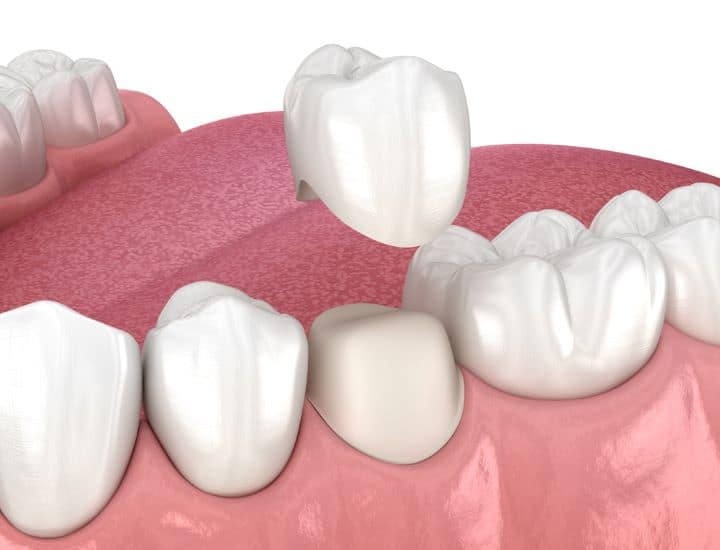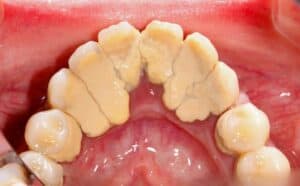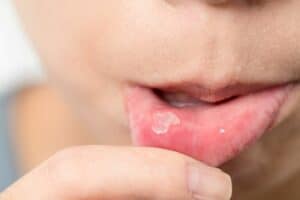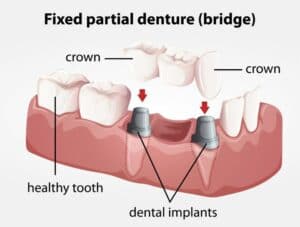90% of Americans aged between 20 and 64 are suffering from some stage of dental cavities according to NIH (National Institute of Dental and Craniofacial Research).
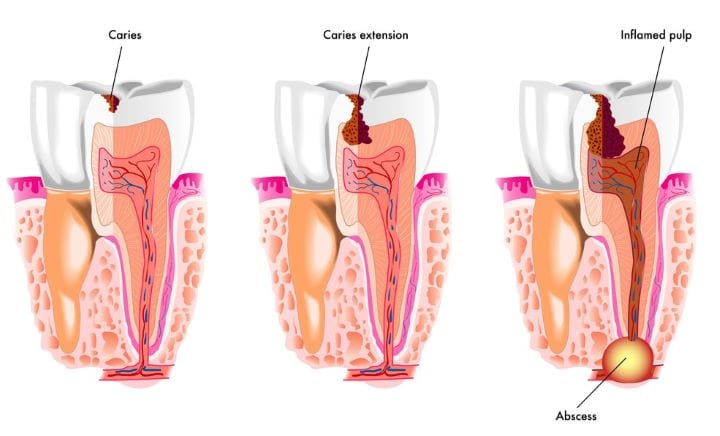
A tooth cavity is something we have been warned about since our childhood, but still, there’s a larger population having dental caries.
Tooth decay appears differently to different people depending on its severity and stages. You may be symptomless or may present to a dentist with a complaint of sensitivity, toothache, swelling, or fever.
Let’s learn all the details about tooth decay – how it happens, the treatment options, and how to prevent it.
Understanding Tooth Decay
- What is tooth decay?
A tooth decay, a dental cavity, or dental caries are the terms used interchangeably at the dental office.
Dental decay, in easy words, is said to be a bacterial infection where the hard enamel surface starts to erode, forming holes in the tooth.
A literal cavity is formed in a tooth surface that will appear as a black or brown hole when viewed by the naked eye.
Our teeth are covered by a plaque biofilm that’s made up of bacteria. The bacteria feed on the starchy food and produce lactic acid as a by-product, which erodes the tooth.
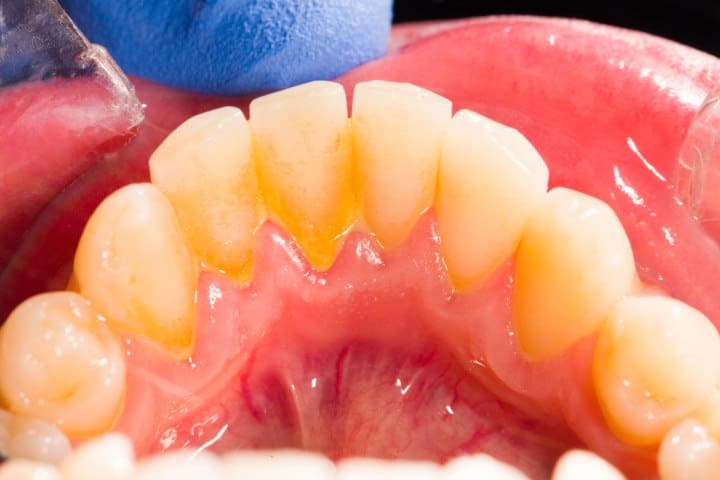
The process isn’t spontaneous, but it happens over periods of months and years.
Let’s say a child habitually eats candies and sweets six times daily. It means the bacteria has the potential to leach out acid six times a day whenever the child eats sticky food, and it sticks to the tooth surface.
Even if the child brushes twice daily, the pH of the mouth decreases six times with the release of acid, which makes the tooth surface more prone to erosion.
That’s why it’s advisable to allow children to eat all sweets and candies once a day so that the pH of the mouth doesn’t fall that frequently to cause caries.
The most common areas where the cavitation develops are the deep pits and grooves on your back teeth and in between two teeth where your toothbrush is hard to reach.
The good news is dental caries are preventable, and early diagnosis can help prevent tooth infection and tooth loss.
- The impact of tooth decay on oral health
Cavities and tooth decay are contagious and, if not diagnosed early, can advance the tooth decay process in the neighboring teeth.
The cavity is a hole that harbors bacteria. This bacteria can be transmitted to caries-prone areas via saliva between different people when they kiss, share foods, or share personal care equipment like toothbrushes.
Early tooth decay is preventable with a simple filling and can also prevent the spread of opportunistic bacteria to the other parts of the oral cavity.
Certain species of bacteria, like streptococcus mutans, are the leaders in forming a cavity.
Stages of Tooth Decay
3.8 billion people are affected by oral diseases, and dental caries is the most prevalent oral condition. It’s most common worldwide and can be of cavitated and non-cavitated types.
Tooth decay happens in several stages, and the earlier the stage, the better the prognosis and vice versa.
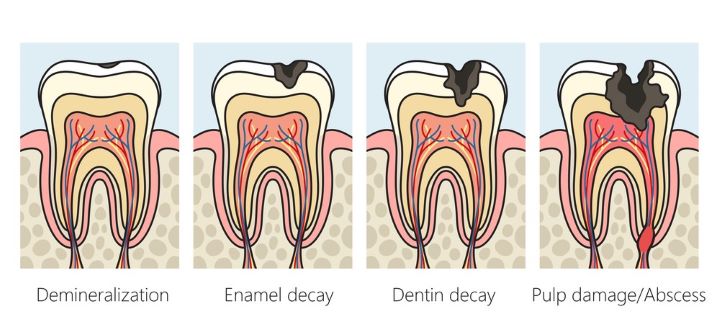
There are five stages of tooth decay, as mentioned:
Stage # 1 – Initial demineralization
The whiter outer surface of the tooth is highly mineralized and is called enamel.
Enamel is the hardest of all tooth surfaces as it contains a lot of calcium, phosphate, and fluoride.
With a lack of fluoridation in your diet, you may have a brittle enamel surface, which is more prone to cavities.
Whenever the enamel is exposed to acids released by bacteria over some time, it starts losing its mineral content.
This leaves a white spot on the tooth, which signifies initial signs of tooth decay or, in other words, tooth demineralization.
Stage # 2 – Enamel Decay
With continuous acid production, the enamel decays further. The white spot on the tooth darkens, revealing a darkened brownish appearance. The enamel completely breaks down in this stage, revealing the yellowish-brown color of the dentine.
#3 – Dentine Decay
Dentine is softer than enamel and lies just below the enamel in the tooth.
As it’s softer, it’s more sensitive to damage from the acid, and it decays faster than enamel. The dentinal decay exposes the nerve endings, which makes your teeth sensitive.
#4 – Pulp Damage
The pulp tissues lie beneath the dentine, and it’s the innermost part of the tooth.
Once caries extend beyond the dentine, they reach the pulp tissues, which are made of lots of blood vessels and nerves. When damage to the pulp happens, it gives a toothache.
Stage # 5: Tooth Abscess
When tooth decay invades the pulp, the bacteria gets an opportunity to spread into the bone.

This forms an abscess right at the bottom of your tooth. This presents with severe pain, swelling, and fever sometimes.
What Causes Tooth Decay?
- Sugary food
Carbohydrates are the food for bacteria. Bacteria live in our mouths 24/7. They eat the carbs and produce lactic acid, which destroys the tooth surface. Frequent carb intake is likely to improve the amount of acid production in the oral cavity; hence, you get cavities.
- Plaque and bacteria
Your teeth are covered with a biofilm called plaque, which is made up of bacteria. The plaque will turn into calculus and tartar if not removed with regular brushing.
It harbors bacteria, which release acid after feeding on sugary foods. This lowers the pH of the oral cavity, making the environment feasible for bacterial growth in caries-prone areas.
- Caries-prone tooth surface
Deep pits and fissures on your back teeth and the surface of the tooth between two teeth are hard to clean. The bacteria grows in these places and forms cavities.
- Time
The process of cavitation is slow and steady.
It occurs over months and years; that’s why practicing good oral hygiene can save you from the disease all your life.
Symptoms of Tooth Decay
- Toothache and sensitivity
The earliest stages of tooth decay may be symptomless or present with sensitivity. As tooth enamel contains no nerve supply, enamel decay will be symptomless.
However, dentine decay will present with sensitivity. The pulpal decay will present with a sharp toothache that might need instant dental help.
You may take over-the-counter medication for the pain relief. It’s better to see the dentist as early as possible for disease control and prevention.
- Visible holes or pits in the teeth
Upon self-examination in a mirror, you’ll be able to appreciate dark brown or black holes in your teeth. Some cavities are hidden, so your dentist may take a bitewing X-ray to see them.
- Discoloration or dark spots on the teeth
A tooth discoloration may suggest a trauma or a dental cavity; a black or brown spot if appreciated on teeth, must be shown to the dentist for prompt treatment and prevention from further progression.
Prevention of Tooth Decay
- Proper oral hygiene practices
Adopting good oral hygiene maintenance practices can do a lot of wonders for your oral health.

Brushing twice daily with a soft bristle brush with the proper brushing technique can help you reduce the risk of getting caries.
Moreover, flossing once daily to remove the food and bacteria from the areas inaccessible by the toothbrush can further reduce the risk; eating xylitol chewing gums can help improve the salivary flow in the oral cavity, which can further reduce the risk of caries.
- Balanced diet and nutrition
Your overall diet will define your oral health. We all know our tooth is made up of minerals.
Moreover, processed foods and foods rich In starch, like sweets and carbonated drinks, are great at lowering the pH of the oral cavity, providing bacteria with an optimum environment to cause cavities.
- Regular dental checkups and cleanings
Seeing a dentist regularly can help you diagnose cavities in their early stages. That means you can save your teeth before it’s too late.
Also, you can get professional scaling and polishing treatment at a dental office to get rid of harmful bacteria professionally.
Treatment Options for Tooth Decay
- Dental fillings
The first line of options for treating tooth cavities is to remove the decayed portion of the tooth and fill the tooth with a filling material. Several dental filling materials are available.
Teeth can be filled with a lot of aspects in mind. Materials like composite resin and porcelains are used to fill the front teeth that have undergone decay.
However, for the back teeth, silver amalgam and gold fillings are used, considering their strength and ability to resist fracture and leakage.
These are all the direct dental fillings and are done by a dentist at the chairside whenever you have scheduled a dental filling appointment with him.
Sometimes, the tooth demands indirect filling with onlays and inlays, which are created in the laboratory once the tooth impression is taken.
Such filings are done in teeth that are hard to restore and need massive strength in the restoration.
- Dental crowns
A dental crown or a tooth cap is used to cover weak, broken, and worn-out teeth. It entirely covers the crown portion of your tooth and snugly fits your tooth surface.
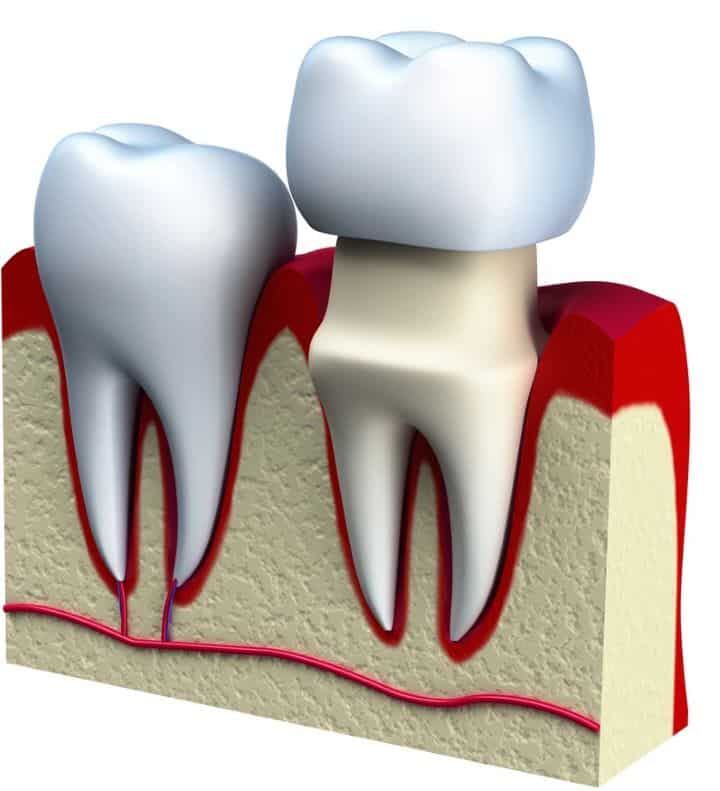
However, your dentist would cut some portion of your tooth to make the crown fit appropriately with the arch. There are different types of crowns based on the materials:
– Metal crowns:
High strength and lasts longer
– Porcelain-fused to metal crowns:
Moderate strength with a natural-like appearance.
– Pressed Ceramic Crowns:
Moderate strength but superior aesthetics.
– All ceramic and porcelain crowns:
They have superior aesthetics and are used in patients with metal allergies.
- Root canal therapy
Tooth decay of stages 4 and 5 seeks a root canal treatment for the tooth. In this case, your dentist will first anesthetize your tooth.
The dentist will carefully remove the decayed part of the tooth and the inflamed pulp, followed by disinfection.
He will then fill the canal with a sealing material, followed by a dental filling and a dental crown. This will save the tooth from extraction and will keep it functional within the oral cavity.
Tips for Maintaining Oral Health
- Brushing and flossing techniques:
Brushing twice daily and flossing once daily can help prevent tooth decay to a great extent.
Here’s how you can do it:
1) Use a pea-sized amount of fluoride toothpaste to brush your teeth with a Soft-Bristled toothbrush. Fluoride helps strengthen the tooth enamel by making a strong bond.
2) Hold the brush at an angle of precisely 45 degrees to stimulate the gingiva. Brush with gentle strokes, cleaning all the surfaces.
3) Don’t forget to brush your tongue as well.
4) After brushing, wash your toothbrush and let it air dry. Don’t cap it instantly.
5) Store your toothbrush in an upright manner.
6) Replace your toothbrush every 3 to 4 months if your bristles seem to work out.
7) Use traditional dental floss or newer flossing methods to floss your teeth.
8) Take an 18-inch floss and wrap it around the index and middle fingers. Slide the floss between your teeth gently until it reaches the gumline. Repeat it for each tooth in your mouth.
9) Swish your oral cavity with a mouthwash if you’re done flossing your teeth.
- Choosing the right dental products
Selecting the right dental tools for oral hygiene maintenance is essential to achieving optimum oral care.
#1 – Choose a soft bristle toothbrush to stimulate gingiva and to prevent wear off of the tooth enamel surface.
#2 – The head size of your toothbrush must be adequate depending on your mouth size. It must have the ability to reach into every corner of your mouth.
#3 – Multi-level angled bristles are effective in removing plaque when compared to flat-trimmed bristles.
#4 – You can opt for either manual toothbrushes or electric toothbrushes. Both have their advantages.
Manual toothbrushes require proper angulation and toothbrushing; however, electric ones come with built-in rotators to ease the workout.
#5- Fluoridated toothpaste is best for improving the health of enamel and reducing the risk of caries.
#6 – There are several other dental products in the market, like water flossers, plaque-disclosing tablets for children, and others to improve self-care.
The Role of Diet in Preventing Tooth Decay
- Impact of sugar and acidic foods on oral health
There’s a strong relationship between cavities and sugars. The bacterial biofilms eat the sugars to produce acidic by-products that demineralize the dental hard tissues.
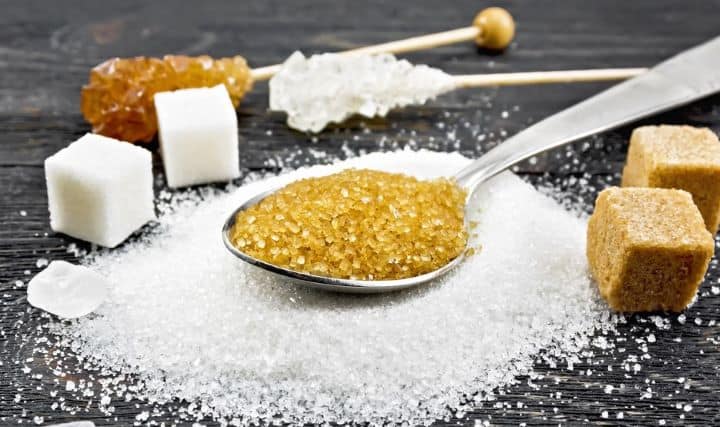
Specifically, it causes a drop in oral pH to 5.5, which provides the best environment for accelerated demineralization.
The relationship between cavities and sugar specifically depends on the type of sugar consumed.
It depends on the quality of the sugar and how quickly it gets fermented by the oral bacteria.
Sucrose and fructose are most cariogenic, and these are highly found in natural syrups, beverages, and fruits.
The plaque is also formed in the presence of sucrose; thus, sucrose is an independent driver of caries.
Another aspect that defines caries progression is the amount of sugar intake and frequency.
Frequent snacking is going to lower the pH several times, providing bacteria with a harmonious environment to remove calcium, phosphate, and fluoride from the enamel surface.
The pH drop stays for 30 minutes, and it returns to normal afterward.
- Nutritious foods that support dental health
There’s always a constant relationship between oral health and nutrition. A balanced diet will not only keep your body functional but will also improve the quality of your oral health.
Dairy products, apples, berries, and fiber-rich products inhibit caries development.
The calcium in dairy products stimulates calcium deposition, while lactose sugar in the milk limits enamel leaching.
This causes a little reduction in oral pH; thus, it doesn’t provide an ideal environment for bacteria to cause cavities.
Another way to prevent caries is to use sugar-free xylitol chewing gums that improve the amount of saliva in the oral cavity.
This will wash away the bacteria and the food particles and keep the environment safe and clean.
3 Foods That Promote Oral Health
1) Cocoa Beans
Who doesn’t love chocolates? Chocolate is a go-to food for Americans, as an average American eats three chocolate bars per week.
Chocolate without added sugar helps prevent cavities by preventing plaque formation.
Polyphenols in cocoa kill cavity-causing bacteria and, for this very reason, were added as an ingredient in mouthwash, according to a study conducted in 2019.
But here’s the key: Have dark chocolate or cacao nibs, or you’ll end up with caries.
2) Green Veggies
Green vegetables are prebiotics and are the food for good bacteria.

The good bacteria feed on it and, in turn, produce nitric oxide, which is good for mouth and cardiovascular health.
Such foods are high in mineral content and fiber; hence, these promote remineralization of tooth surfaces. Some of them are spinach, turnips, chard, and arugula.
3) Grass-feed dairy
Cheese and butter are rich in vitamin K2, which promotes the health of teeth. Vitamin K2 is different than K1 and is a fat-soluble vitamin.
Healthy bacteria produce it in the guts. It helps improve the mineral density of bones and teeth by funneling calcium. It builds new dentine and slows tooth degradation.
Nursing Bottle Carries
In an attempt to provide comfort to children, parents are a great contributor in helping their children get nursing bottle caries.
Providing children with a bottle of milk or juice at night or a pacifier dipped in syrup as a soother is the primary cause of baby bottle tooth decay or early childhood caries.
As the child falls or falls asleep, the milk or juice pools in the space between the lips and teeth.
The streptococcus mutants act on it to produce lactic acid, which destroys the young enamel and makes it carious.
How to Prevent Early Childhood Caries?
1) Mothers can transfer their carious saliva to their babies by feeding them through common feeding spoons.
Try not to share feeding spoons or licking pacifiers with your child. Also, wipe their gums and teeth with fresh gauze after every feeding.
2) Start brushing your child’s teeth from the time the tooth appears in its oral cavity. Use a child-size toothbrush and a smear size of toothpaste till the age of 3.
3) Don’t provide juice or milk in a bottle to your babies during the night.
4) Use a pea-sized amount of toothpaste for brushing from age 3 to 6.
5) Supervise your child’s brushing until age 7. At this age, a child’s swallowing reflex is developed, and he would no longer swallow the toothpaste.
6) Always choose fluoridated toothpaste for your child.
7) If your child uses a pacifier, make sure it’s clean and not dipped in sugar.
8) Encourage healthy eating habits.
9) Make sure your child is habitual if brushing twice daily.
10) Get early fluoride treatment of deep pits and issues on the chewing surfaces of back teeth.
Tooth Decay Treatment Guideline by American Dental Association
Recently, in 2023, a panel of experts at the ADA Council suggested new guidelines for saving a tooth after tooth decay.
The guideline was published in the Journal of the American Dental Association after a panel of dentists discussed 300 studies altogether.
It says a dentist must remove active caries while saving most of the original tooth to achieve better tooth outcomes and less likely nerve exposure of a tooth.

